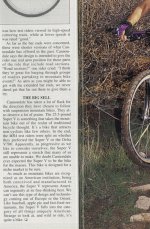Brotrob
Member
Hi all,
I am trying to understand the difference between the fundamental Super V swingarm design options:
- 1993 - 1995 - Aluminium or Carbon "Elevated Chain Stay" Swingarm with higher pivot point and shock against the seat support
- 1996 onwards - Aluminium "Super Active" swingarm made from aluminium tubing with low pivot neat bottom bracket and shock against the fat down-tube
The old version swingarm 1993-1995 seems to have the following pros and cons
Pro:
- much lighter
- eliminates chain suck
Con
- cannot drop the seatpost without hitting the shock
- Ride quality?
Have I understood this correctly? I am particularly interested in the last point - how does the ride quality differ between the two versions? Is the old version bobbling more? Is it less stiff (laterally)?
What were the engineering reasons for changing the design?
Any comments would be greatly appreciated
For reference: here the old version:

And the new version (active)

I am trying to understand the difference between the fundamental Super V swingarm design options:
- 1993 - 1995 - Aluminium or Carbon "Elevated Chain Stay" Swingarm with higher pivot point and shock against the seat support
- 1996 onwards - Aluminium "Super Active" swingarm made from aluminium tubing with low pivot neat bottom bracket and shock against the fat down-tube
The old version swingarm 1993-1995 seems to have the following pros and cons
Pro:
- much lighter
- eliminates chain suck
Con
- cannot drop the seatpost without hitting the shock
- Ride quality?
Have I understood this correctly? I am particularly interested in the last point - how does the ride quality differ between the two versions? Is the old version bobbling more? Is it less stiff (laterally)?
What were the engineering reasons for changing the design?
Any comments would be greatly appreciated
For reference: here the old version:
And the new version (active)


